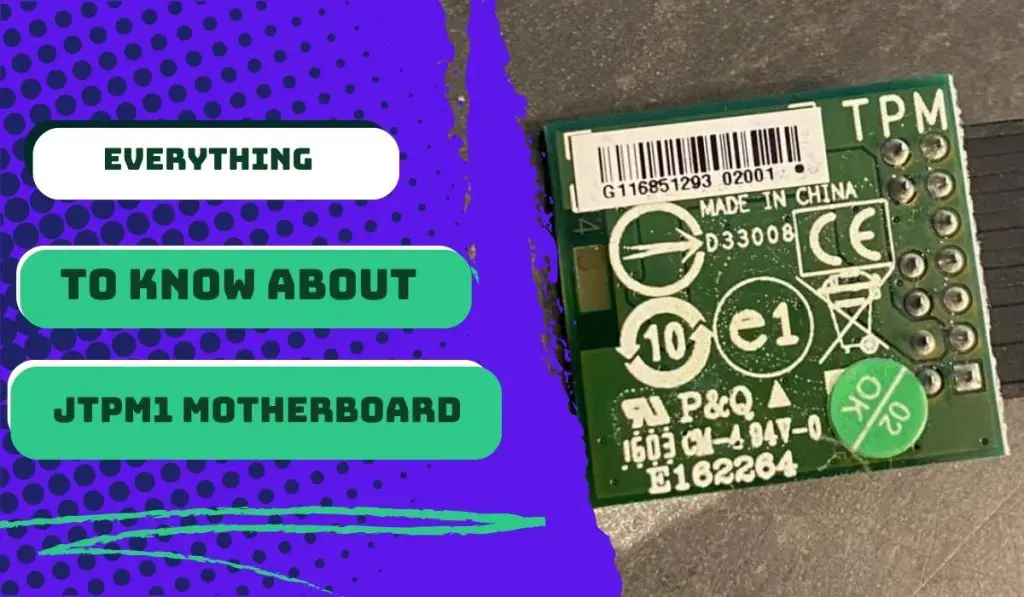The JTPM1 motherboard component is a Trusted Platform Module (TPM) header that allows users to connect a TPM module to their motherboard. TPM modules are hardware-based security chips that provide encryption, secure boot, and identity verification. JTPM1 allows users to add important security features to their computers.
As a tech enthusiast, I’m always looking for ways to improve the performance and security of my computers. That’s why I was so excited to use the JTPM1 motherboards. I recently built a new computer using a JTPM1 motherboard. I was impressed by how easy it was to install the TPM module, which I did by plugging the TPM module into the JTPM1 header on my motherboard. Once I had installed the TPM module, I enabled encryption for my computer’s hard drive. I also enabled secure boot, which ensures that only trusted software is loaded on my computer at startup.
So, in this article, I will discuss the JTPM1 on various motherboard brands. I will also talk about the JTPM1 header, the JTPM1 cable, and the JTPM1 connector. I will also share the significance of the JTPM1 motherboard component and its role in modern computer systems.
What Are the Benefits of The JTPM1 Motherboard?
A JTPM1 motherboard is a motherboard that has a Trusted Platform Module (TPM) header. TPM headers are used to connect TPM modules, which are hardware security chips that provide a number of benefits, including encryption, secure boot, and identity verification.
The purpose of the JTPM1 header is to allow you to connect a TPM module to your motherboard. TPM modules can be used to improve the security and performance of your computers, as seen below:
- Encryption: TPM modules can be used to encrypt data stored on your computer’s hard drive or SSD. This can help protect your data from unauthorized access, even if your computer is lost or stolen.
- Secure boot: TPM modules can be used to ensure that only trusted software is loaded on your computer at startup. This can help protect your computer from malware and other security threats.
- Identity verification: TPM modules can be used to verify the computer’s and its user’s identity. This can be useful for applications such as secure login and online banking.
There are a number of benefits to using a JTPM1 motherboard, including:
- Enhanced security: Since this can help to protect my data from unauthorized access, even if my computer is lost or stolen, it gives me security assurance with a strong backup defense against malware and other security threats.
- Improved performance: TPM modules can be used to improve the performance of overclocked computers by providing a secure way to store overclocking settings. TPM modules can also be used to improve the security of virtual machines by providing a secure way to store virtual machine keys.
- Peace of mind: Knowing that your computer is more secure thanks to a TPM module can give you peace of mind. I can attest to this after I installed it on mine.
JTPM1 Header
The JTPM1 header is a 14-pin header on the motherboard that is used to connect a Trusted Platform Module (TPM) module. TPM modules are hardware security chips that provide a number of security features, such as encryption and secure boot.
Most motherboard headers are designed to connect to specific devices, such as power buttons, LED lights, or fans. The JTPM1 header, on the other hand, is designed specifically to connect to a TPM module.
The location of the JTPM1 header varies depending on the motherboard manufacturer and model. However, it is typically located near the bottom of the motherboard, near the PCIe slots or SATA ports.
The following table shows the pinout of the JTPM1 header:
| Pin | Signal |
| 1 | Ground |
| 2 | +3.3V |
| 3 | Reserved |
| 4 | Reserved |
| 5 | TPM_CLK |
| 6 | TPM_RESET |
| 7 | TPM_DATA0 |
| 8 | TPM_DATA1 |
| 9 | TPM_DATA2 |
| 10 | TPM_DATA3 |
| 11 | TPM_DATA4 |
| 12 | TPM_DATA5 |
| 13 | TPM_SDA |
| 14 | TPM_SCL |
The JTPM1 header is compatible with both TPM 2.0 and TPM 1.2 modules. However, some TPM modules may require a specific type of cable to be connected to the JTPM1 header.
JTPM1 Cables
JTPM1 cables are typically made of a shielded twisted pair (STP) cable. This type of cable is used to reduce electromagnetic interference (EMI) and radio frequency interference (RFI). There are two types of JTPM1 cables:
- TPM 2.0 cable
- TPM 1.2 cable
JTPM1 cables are typically available in lengths of 15 cm and 30 cm, and you can purchase them from a variety of online and offline retailers. I got mine from Amazon, but you can also get them from others like Newegg and Micro Center.
When choosing a JTPM1 cable, it is important to make sure that the cable is compatible with both your TPM module and your motherboard. You can check the compatibility of a JTPM1 cable by consulting the documentation for your TPM module and your motherboard.
It is also important to note that some TPM modules may require a specific type of cable to be connected to the JTPM1 header. For example, my TPM module required a cable with a specific connector type—right-angle connector.
If you are unsure which type of JTPM1 cable to purchase, I recommend contacting the manufacturer of your TPM module for assistance.
JTPM1 Connector
It is important to make sure that the connection between the TPM module and the JTPM1 header is secure and proper. A loose or insecure connection can cause problems with the TPM module and prevent it from functioning properly.
To connect a TPM module to a JTPM1 header, follow these steps:
- Make sure that the TPM module and the motherboard are both powered off.
- Locate the JTPM1 header on the motherboard.
- Align the pins on the TPM module with the pins on the JTPM1 header.
- Gently press the TPM module into the JTPM1 header until it is fully seated.
- Screw the TPM module into the motherboard using the included mounting screw.
Once the TPM module is connected to the JTPM1 header, you can power on the computer and start using the TPM module’s security features.
JTPM1 Motherboard Across Leading Brands
Popular motherboard manufacturers have recognized the importance of the JTPM1 header and have incorporated it into their products. Let’s take a closer look at some of these brands and compare how they implement this feature:
- ASUS: ASUS motherboards often feature a JTPM1 header prominently placed on the board for easy accessibility. They are known for their user-friendly BIOS interfaces, which make enabling TPM (Trusted Platform Module) a straightforward process. ASUS provides robust security options that complement the JTPM1 header, enhancing system protection.
- GIGABYTE: GIGABYTE motherboards also offer JTPM1 headers across various product lines. They emphasize reliability and durability, ensuring a secure and stable connection for TPM modules. GIGABYTE’s motherboards are known for their strong build quality, making them a popular choice among gamers and professionals alike.
- MSI: MSI incorporates JTPM1 headers on many of their motherboards, catering to a wide range of users. Their motherboards often come with software utilities that simplify TPM activation and management. MSI focuses on delivering a seamless experience for users concerned about system security.
- ASRock: ASRock includes JTPM1 headers in their motherboard designs, even in their budget-friendly options. They provide detailed BIOS settings to configure TPM easily and tailor it to specific security needs. ASRock’s approach makes TPM accessible to a broader audience of PC builders.
- EVGA: EVGA, known for its high-performance motherboards, also offers JTPM1 headers. They emphasize compatibility and performance, ensuring that the JTPM1 header integrates seamlessly into their motherboard ecosystem. EVGA’s focus on gaming and overclocking appeals to enthusiasts looking for advanced features.
In comparative analysis, while all these brands incorporate the JTPM1 header, their emphasis often varies. ASUS prioritizes user-friendly security, GIGABYTE leans towards robustness, MSI offers simplicity, ASRock focuses on accessibility, and EVGA targets high performance. Choosing the right brand and motherboard depends on your specific needs, whether it’s gaming, productivity, or security, but rest assured that they all recognize the importance of the JTPM1 header in modern computing.
Conclusion
In conclusion, all major motherboard brands offer motherboards with JTPM1 headers. However, there are some minor differences in how different brands implement this feature.
If you are looking for a motherboard with a JTPM1 header, I recommend you choose a motherboard from a reputable brand such as Asus, Gigabyte, MSI, or ASRock. These brands offer high-quality motherboards that are compatible with a wide range of TPM modules.
Have you used a JTPM1 motherboard before, or are you planning on getting one? Let me know what you think in the comments.
Thank you for reading!



![MSI EZ Debug LED - How To Troubleshoot and Fix[Guide] 4 How to Troubleshoot MSI Debug LED](https://bestofmotherboard.com/wp-content/uploads/2022/02/How-to-Troubleshoot-MSI-Debug-LED.jpg)
![What is Game Boost MSI - [Detailed-Guide] 5 What is Game Boost MSI](https://bestofmotherboard.com/wp-content/uploads/2022/02/What-is-Game-Boost-MSI.jpg)
![[Fixed] MSI Motherboard White Light 6 MSI-Motherboard-White-Light](https://bestofmotherboard.com/wp-content/uploads/2022/10/Asus-Motherboard-White-Light.jpeg)